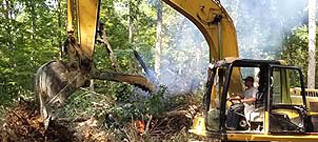Environmental Commentary by Sara Kaplaniak
When I look out into nature, I don’t just see a pretty landscape. If I look closely enough, I see everything we need.
Take freshwater mussels, once common in North America’s rivers and streams before deteriorating water quality left many threatened or endangered. Often mistaken for rocks, an unassuming mussel can remove bacteria, algae and small particles from up to eight gallons of water per day. When hundreds of these critters gather along a stretch of river – watch out!
Similarly subtle are earthworms. Mostly out of sight except for during the occasional rainstorm, earthworms guide water, air and organic matter towards trees, shrubs, crops and other living organisms while busily burrowing underground.
Bees, bats, birds and butterflies advance pollination – a global process that facilitates reproduction in 90 percent of the world’s flowering plants. In fact on average, one in every three bites of food humans eat is produced as a result of a visit from animal pollinators.
At sea, horseshoe crabs seemingly float in the surf, sometimes landing topsy-turvy along the shore. But under the hard shells of these prehistoric creatures flows copper-based blood with primitive cells containing a naturally-derived substance called Limulus Amoebocyte Lysate (LAL) for which there is no synthetic substitute. When LAL comes into contact with bacterial toxins, clotting occurs, a reaction that aids in testing the sterility of vaccines, drugs, prosthetics and other medical devices.
These species and the landscapes in which they reside make up ecosystems, which support all life on Earth. At their healthiest, ecosystems like forests clean the water and air, oceans regulate climate, and wetlands provide a buffer from floods and storms.
If we look closely, we see that everything in nature has a purpose. Disrupting this balance jeopardizes the air we breathe, the food we eat and water upon which all life depends. Sometimes, it even leads us to seek expensive and intrusive methods of duplicating what nature had already provided for free.
This almost happened when agricultural and sewage runoff in the Catskills watershed threatened the clean supply of water enjoyed by residents of New York City. However, instead of pursuing a filtration plant estimated to cost up to eight billion dollars, New York City invested a fraction of that into restoring the Catskill's watershed to a more natural state that supports clean water. For more than a decade, New York City has purchased land, acquired easements from landowners willing to restrict development on their property and subsidized septic system improvements to ensure a water supply deemed to be so clean that consideration of additional water filtration has been postponed until at least 2017.
This is exciting because New York City displayed a rare example of calculating nature into a public policy and budgeting decision. In enviro-speak, this additional line on the balance sheet is referred to “ecosystem services.” Determining the value of services provided by mussels and earthworms and forests and rivers is gaining steam, recently entering into conversations about Maryland’s landscape and the Chesapeake Bay.
In 2010, Maryland Governor Martin O’Malley established an Ecosystems Services Working Group (ESWG) to identify ways of recovering the true costs of ecosystem services lost through land conversion and infrastructure development. In a report released last fall, the ESWG confirmed that although Maryland has one of the most protective forest conservation laws in the nation, the state loses approximately 7,000 acres of forests each year to development without ever accounting for the value of lost environmental benefits. Similar analyses were conducted for the state’s non-tidal wetlands, coastal bays and other waterways.
My own state of Pennsylvania would benefit from this creative way of conducting business. For example, a healthier, less developed landscape lining the Susquehanna River might have been more resilient in the wake of last September’s visit from Tropical Storm Lee. Instead, resulting floods destroyed properties, paralyzed towns and sent debris, sewage, farm runoff and mud into Chesapeake Bay.
It doesn’t have to be that way, but it will be if we think that clearing land and replacing it with a small pond or a few trees will suffice. Pennsylvania’s rivers, streams and forests took centuries to become the natural empires they are today. In fact, I suspect that if we quantified the value of our ecosystems, we may find that their contributions and worth dwarf Bill Gates, Warren Buffett, Oprah and other billionaires!
I look forward to watching governments, corporations and non-profit organizations recognize, value and incorporate nature into business models and decisions. I doubt it will take them long to realize the many incentives for protecting and restoring nature in lieu of more destruction. Then, we’ll really put these landscapes to work.
Sara Kaplaniak lives and writes in Pennsylvania, where she reduces, reuses and recycles along with her husband and two kids. Distributed by Bay Journal News Service.


